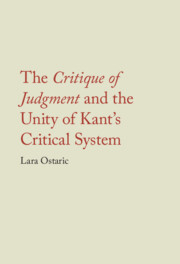35 results
Concluding Remarks
- from Part III - Teleological Judgment and the “Moral Image”
-
- Book:
- The <i>Critique of Judgment</i> and the Unity of Kant's Critical System
- Published online:
- 15 August 2023
- Print publication:
- 10 August 2023, pp 263-266
-
- Chapter
- Export citation
Acknowledgments
-
- Book:
- The <i>Critique of Judgment</i> and the Unity of Kant's Critical System
- Published online:
- 15 August 2023
- Print publication:
- 10 August 2023, pp viii-viii
-
- Chapter
- Export citation
Chapter 1 - Kant’s Justification of the “Fact of Reason” and the Objective Reality of Freedom from a “Practical Point of View”
- from Part I - The Highest Good and the Postulates
-
- Book:
- The <i>Critique of Judgment</i> and the Unity of Kant's Critical System
- Published online:
- 15 August 2023
- Print publication:
- 10 August 2023, pp 19-46
-
- Chapter
- Export citation
Chapter 4 - Beauty as a “Symbol of Morality”
- from Part II - Aesthetic Judgment and the “Moral Image”
-
- Book:
- The <i>Critique of Judgment</i> and the Unity of Kant's Critical System
- Published online:
- 15 August 2023
- Print publication:
- 10 August 2023, pp 101-122
-
- Chapter
- Export citation
Chapter 5 - The Free Harmony of the Faculties and the Primacy of Imagination in Kant’s Aesthetic Judgment
- from Part II - Aesthetic Judgment and the “Moral Image”
-
- Book:
- The <i>Critique of Judgment</i> and the Unity of Kant's Critical System
- Published online:
- 15 August 2023
- Print publication:
- 10 August 2023, pp 123-149
-
- Chapter
- Export citation
Contents
-
- Book:
- The <i>Critique of Judgment</i> and the Unity of Kant's Critical System
- Published online:
- 15 August 2023
- Print publication:
- 10 August 2023, pp v-vii
-
- Chapter
- Export citation
Part I - The Highest Good and the Postulates
-
- Book:
- The <i>Critique of Judgment</i> and the Unity of Kant's Critical System
- Published online:
- 15 August 2023
- Print publication:
- 10 August 2023, pp 17-98
-
- Chapter
- Export citation
Chapter 2 - The Highest Good and the Realism of Moral Glaube
- from Part I - The Highest Good and the Postulates
-
- Book:
- The <i>Critique of Judgment</i> and the Unity of Kant's Critical System
- Published online:
- 15 August 2023
- Print publication:
- 10 August 2023, pp 47-71
-
- Chapter
- Export citation

The Critique of Judgment and the Unity of Kant's Critical System
-
- Published online:
- 15 August 2023
- Print publication:
- 10 August 2023
Part II - Aesthetic Judgment and the “Moral Image”
-
- Book:
- The <i>Critique of Judgment</i> and the Unity of Kant's Critical System
- Published online:
- 15 August 2023
- Print publication:
- 10 August 2023, pp 99-176
-
- Chapter
- Export citation
Chapter 9 - Kant’s Teleological Philosophy of History
- from Part III - Teleological Judgment and the “Moral Image”
-
- Book:
- The <i>Critique of Judgment</i> and the Unity of Kant's Critical System
- Published online:
- 15 August 2023
- Print publication:
- 10 August 2023, pp 235-262
-
- Chapter
- Export citation
Kant’s Writings by Abbreviations Used for German Titles with Corresponding Translations
-
- Book:
- The <i>Critique of Judgment</i> and the Unity of Kant's Critical System
- Published online:
- 15 August 2023
- Print publication:
- 10 August 2023, pp x-xvi
-
- Chapter
- Export citation
Introduction
-
- Book:
- The <i>Critique of Judgment</i> and the Unity of Kant's Critical System
- Published online:
- 15 August 2023
- Print publication:
- 10 August 2023, pp 1-16
-
- Chapter
- Export citation
Part III - Teleological Judgment and the “Moral Image”
-
- Book:
- The <i>Critique of Judgment</i> and the Unity of Kant's Critical System
- Published online:
- 15 August 2023
- Print publication:
- 10 August 2023, pp 177-266
-
- Chapter
- Export citation
Bibliography
-
- Book:
- The <i>Critique of Judgment</i> and the Unity of Kant's Critical System
- Published online:
- 15 August 2023
- Print publication:
- 10 August 2023, pp 267-276
-
- Chapter
- Export citation
Index
-
- Book:
- The <i>Critique of Judgment</i> and the Unity of Kant's Critical System
- Published online:
- 15 August 2023
- Print publication:
- 10 August 2023, pp 277-280
-
- Chapter
- Export citation
Copyright page
-
- Book:
- The <i>Critique of Judgment</i> and the Unity of Kant's Critical System
- Published online:
- 15 August 2023
- Print publication:
- 10 August 2023, pp iv-iv
-
- Chapter
- Export citation
Note on Sources
-
- Book:
- The <i>Critique of Judgment</i> and the Unity of Kant's Critical System
- Published online:
- 15 August 2023
- Print publication:
- 10 August 2023, pp ix-ix
-
- Chapter
- Export citation
Chapter 7 - Kant’s Account of Nature’s Systematicity and the Unity of Theoretical and Practical Reason
- from Part III - Teleological Judgment and the “Moral Image”
-
- Book:
- The <i>Critique of Judgment</i> and the Unity of Kant's Critical System
- Published online:
- 15 August 2023
- Print publication:
- 10 August 2023, pp 179-205
-
- Chapter
- Export citation
Chapter 3 - Reflective Judgment and the Realism of the “Moral Image”
- from Part I - The Highest Good and the Postulates
-
- Book:
- The <i>Critique of Judgment</i> and the Unity of Kant's Critical System
- Published online:
- 15 August 2023
- Print publication:
- 10 August 2023, pp 72-98
-
- Chapter
- Export citation



